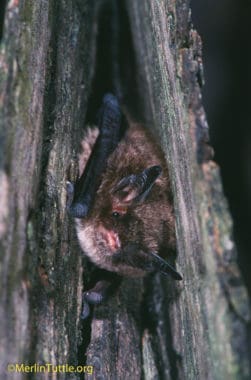The Costs of Bat Decline
Can we afford to lose bats? A recent study by Eyal Frank of the University of Chicago reveals that the dramatic decline in U.S. bat
Merlin has been asked to comment on the U.S. Fish and Wildlife proposal to prepare a draft of a 50-year environmental impact statement that will affect bats and humans.
The U.S. Fish and Wildlife Service, announces their intent to prepare a draft environmental impact statement (EIS) for proposed issuance of an incidental take permit (ITP) under the Endangered Species Act (ESA) for the draft Oil & Gas Coalition Multi-State Habitat Conservation Plan (O&G HCP). The O&G HCP is being developed to streamline environmental permitting and compliance with the ESA for nine companies in conjunction with their respective midstream and upstream oil and gas exploration, production, and maintenance activities in Ohio, Pennsylvania, and West Virginia over a 50-year period. The companies have indicated that they intend to request ITP coverage for five bat species: The endangered Indiana bat (Myotis sodalis), the threatened northern long-eared bat (Myotis septentrionalis), the little brown bat (Myotis lucifugus), the eastern small-footed bat (Myotis leibii), and the tri-colored bat (Perimyotis subflavus).
For more information and details about the intended proposal, click HERE.
Merlin has provided his statement below after discussing the proposal with a U.S. FWS representative.
We invite you to leave your comments as well via this link. The deadline for comments is December 27th.
It is my understanding that the “incidental take” issue, as it pertains to bats in this case, simply limits the time of year when forest clearing for items such as wells, access roads and gas lines can occur. It does not prevent cutting of bat roosting trees. It just prevents cutting them during the bats’ active season. As traditionally enforced, I doubt its relevance to long-term population trends of tree-roosting bats. Industry undoubtedly could gain big saving from being allowed to work year-round instead of just in winter. If a portion of those savings could be invested in long-term protection of quality habitat, the net result could be positive for all concerned.
Unless negotiations are allowed to proceed, we cannot know that the outcome would be bad for bats. I am concerned regarding how mitigation funds are spent. They should not be wasted on attempts to stop or cure WNS. This horrible, bat-killing disease cannot be stopped, and it is extremely unlikely that a practically implementable cure will be found. It is time to focus conservation efforts on protection of key habitats.
In addition to protecting roosting habitats, we must also be seriously concerned about impacts on water availability and contamination. These issues also directly impact humans, endangered fish and mussels, and a wide variety of other wildlife.
Finally, any 50-year agreement must recognize that major changes, both technologically and environmentally, will likely occur. It is essential that sufficient flexibility be included to ensure equitable and effective implementation over a lengthy period of potentially rapid change. This agreement could be good for all concerned if negotiated under fair-minded leadership.

Love our content? Support us by sharing it!
Can we afford to lose bats? A recent study by Eyal Frank of the University of Chicago reveals that the dramatic decline in U.S. bat
Bats are among the most fascinating yet misunderstood creatures in the natural world, and for many conservationists, a single experience can ignite a lifelong passion
Many bat conservationists know that Kasanka National Park in Zambia is an exceptional place for bats, but it is also the place that sparked my
The Kasanka Trust is a non-profit charitable institution, which secures the future of biodiversity in Kasanka National Park in Zambia. They welcome internships for students
2024 © Merlin Tuttle’s Bat Conservation. All rights reserved.
Madelline Mathis has a degree in environmental studies from Rollins College and a passion for wildlife conservation. She is an outstanding nature photographer who has worked extensively with Merlin and other MTBC staff studying and photographing bats in Mozambique, Cuba, Costa Rica, and Texas. Following college graduation, she was employed as an environmental specialist for the Florida Department of Environmental Protection. She subsequently founded the Florida chapter of the International DarkSky Association and currently serves on the board of DarkSky Texas. She also serves on the board of Houston Wilderness and was appointed to the Austin Water Resource Community Planning Task Force.
Michael Lazari Karapetian has over twenty years of investment management experience. He has a degree in business management, is a certified NBA agent, and gained early experience as a money manager for the Bank of America where he established model portfolios for high-net-worth clients. In 2003 he founded Lazari Capital Management, Inc. and Lazari Asset Management, Inc. He is President and CIO of both and manages over a half a billion in assets. In his personal time he champions philanthropic causes. He serves on the board of Moravian College and has a strong affinity for wildlife, both funding and volunteering on behalf of endangered species.